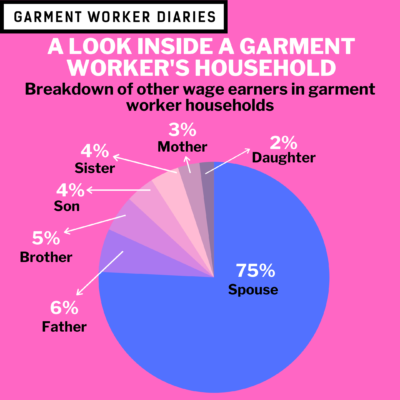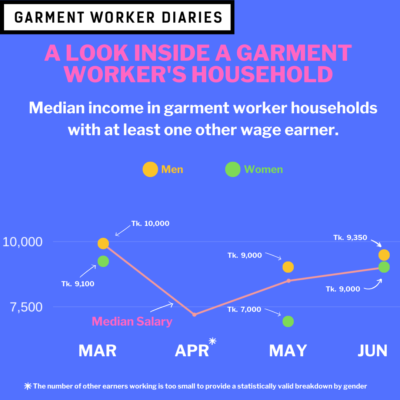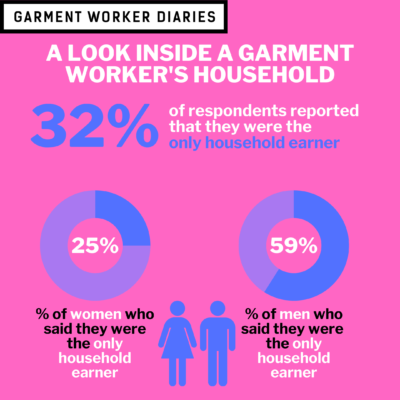MFO and SANEM are continuing to interview garment workers in Bangladesh during the COVID-19 crisis. For the past 15 weeks we have been paying close attention to their work hours, salaries, the digitization of their wages, and their financial decision-making to understand the conditions they are working and living in compared to the pre-COVID era.
Many garment workers live in households with multiple earners. We wanted to get a sense of how many other members of the household are wage earners and how those earners are contributing to the household’s finances. Here’s what garment workers told us:
Household Earner Demographics
We asked garment workers in Bangladesh how many wage earners were living in their household not including themselves.
- 32% of respondents reported that they were the only household earner
- 25% of women said that they were the only household earner, compared to 59% of men who said the same.
The focus of the rest of this blog is on the remaining 68% of households in which there was an additional wage earner living at home other than the respondent themselves, and where the respondent was able to secure the consent of the other household member(s) to report on their economic activity—79% of households with more than one earner gave consent. Of these households:
- About 93% of respondents reported one additional wage earner in the household
- About 7% of respondents reported two additional wage earners
- Less than 1% of respondents reported three or more additional wage earners
In addition:
- 75% of respondents said that one of the other wage earners in the household was their spouse
- 77% of women reported that one of the other earners was their spouse, compared to 62% of men
- 6% of respondents reported that one of the other earners was their father
- 5% of respondents reported that one of the other earners was their brother
- 4% of respondents reported that one of the other earners was their son
- 4% of respondents reported that one of the other earners was their sister
- 3% of respondents reported that one of the other earners was their mother
- 2% of respondents reported that one of the other earners was their daughter
Wages and Work Hours of Household Earners
We also asked the respondents to find out the wages and work hours of other earners in the household for March through June 2020:
In March 2020:
- 88% of the other household earners went to work
- 85% of other household earners that were women went to work compared to 88% of men
- The median work hours reported for other household earners was 216, for both men and women
- The median salary amount reported for the other household earners was Tk. 10,000
- The median salary of the other household earners that were women was Tk. 9,100 compared to Tk. 10,000 for men
In April 2020:
- Only 32% of other household earners went to work
- The median work hours reported for other household earners was 128
- The median salary amount of the other household earners was Tk. 7,200
(The number of other earners working is too small to provide a statistically valid breakdown by gender).
In May 2020:
- 82% of other household earners were back at work
- 90% of other household earners that were women went to work compared to 80% of men
- The median work hours reported for other household earners was 217
- The median work hours for women was 216 compared to 220 for men
- The median salary amount of the other household earners was Tk. 8,500
- The median salary of the other household wage earners that were women was Tk. 7,000 compared to Tk. 9,000 for men
In June 2020:
- 94% of other household earners went to work, with no difference between women and men
- The median work hours reported for other household earners was 234, with little difference between women and men
- The median salary amount of the other household earners was Tk. 9,000, with little difference between women and men
The most commonly reported job type for other wage earners across all four months, and by both women and men, was ‘garment worker’ with 40% to 45% of all other household earners (depending on the month) working in the garment sector.
All data presented here come from interviews conducted over the phone with a pool of 1,364 workers. These workers are employed in factories spread across the five main industrial areas of Bangladesh (Chittagong, Dhaka City, Gazipur, Narayanganj, and Savar). Just over three-quarters of the working respondents are women, roughly representative of workers in the sector as a whole.




